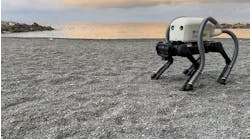Podcast: Game-Changing Textiles: Recent Advancements and Innovations
From garments that capture carbon emissions to self-healing fabrics, 3D-printed clothing, temperature-responsive fibers, and even textiles inspired by spider silk, we'll be uncovering the cutting-edge developments poised to revolutionize how we think about clothing and materials. In this episode, we take a closer look at these fascinating inventions, their potential impact on sustainability, performance, and design, and what the future holds for the textile industry.
All the innovations discussed in this episode are available in article form at the links below:
- Carbon Emission Clothing May Be Coming to a Walmart Near You: https://newequipment.com/21272038
- Self-Healing Clothes May Become a Reality Thanks to Fungi: https://newequipment.com/21272038
- LED Dress Opens Door to the Future of 3D Printing: https://www.newequipment.com/21282046
- Shape-Shifting Fibers Expand and Contract Based on Body Temperature: https://newequipment.com/21278388
- The Future of Textiles Lies in Spider Silk: https://www.newequipment.com/21283821
Below is the transcript:
Hi everyone! Welcome back. Happy Tuesday and happy March! You're listening to Great Question: A Manufacturing Podcast. I'm Laura Davis, Editor-in-Chief of New Equipment Digest and today we're going to take a look at a few of the most recent advancements and innovations in textiles which include shape-shifting fibers, tougher than steel fibers, self-healing clothing, 3D printed clothing, and carbon-emission clothing.
So, let's get into it.
First up, we have carbon-emission clothing.
Everyone from large manufacturing companies to individual consumers is looking for new and innovative ways to be more sustainable and cut costs. At first glance, this may seem like a daunting task, but what if something as potentially harmful as CO2 emissions could be converted into a fashionable garment? It might sound unrealistic, but one company is making it happen, and the world’s largest retailer could soon become their biggest client.
California natives Neeka and Leila Mashouf grew up with a love of nature, science, and fashion, inspired by their surroundings and their family’s fashion business to discover new ways to make sustainable fabrics. The twin sisters founded Rubi Laboratories in 2021 with the intent to make cellulosic textiles from 100% carbon dioxide. According to the company, CO2 emissions are diverted into the Rubi system instead of being released into the air. The CO2 is then converted into pure cellulose pulp using enzymes. From there, the pulp is spun into fibers, yarn, and textiles that can be used in the production of various fabrics and clothes. The company claims that one pair of jeans produced using this method prevents 20 bathtubs full of CO2 from entering the atmosphere, and the garment is biodegradable at the end of its life. When compared to other textiles, the company says that their material costs less, is carbon-negative, and is water and land-neutral.
In a Vogue Business article, Rubi CEO Neeka Mashouf said, quote: “The fashion industry and supply chain need to be reinvented. I don't believe we’re going to achieve our big sustainability goals by iteratively improving the technologies we use today. Those technologies are inherently tied to the degradation of the planet. And moving away from using so much land and water for agriculture is going to be really important. What we're really looking at building at Rubi is an entire reinvention of the way that supply chains work.” end quote.
Recently, Rubi announced that it will be partnering with Walmart to bring its innovative ideas and message to the masses. The pilot project will utilize emissions from manufacturers and facilities in the Walmart supply chain and convert them into different garments. During the pilot, both companies will explore how this green technology could be utilized on a large scale, as well as testing the performance and durability of clothing pieces created through the carbon capture process. If the pilot is successful, an apparel collection at the worldwide retailer is possible.
In a recent article, Andrea Albright, EVP of Sourcing at Walmart, said, quote: “When I toured the Rubi facility earlier this year, I got to see their carbon capture process firsthand, and it felt like magic, this creation of something seemingly out of thin air. The science, though, is more exciting. It started with trees. Rubi founders Neeka and Leila Mashouf took inspiration from how trees “eat” CO2 to create needed cellulose to grow and have figured out a way to mimic this natural process in the lab. Their patent-pending process, like trees, captures and converts carbon emissions, spinning the resulting cellulose into something we all need: fabric. The final products are carbon-negative, resource-neutral textiles that can be used for clothing and other materials.” end quote.
So, keep an eye out at your nearest Walmart for carbon-emission clothing within the next year or two. If the pilot works, this would be a huge change in how we handle emissions from manufacturing.
Next, we have an invention touted as self-healing clothing.
We all know the feeling when we realize there's a hole in our favorite shirt: "oh, no!", bringing your mood down for a minute or two as you deal with the loss. Maybe some of us keep wearing it, convincing ourselves that it’s not that noticeable or trying to hide it beneath a well-positioned jacket. Some of us might relegate the garment to in-home wear only, pretending that the hole adds character and authenticity to the shirt. But we all know what's coming. With each washing, the t-shirt is slowly evolving from beloved attire to a trusty rag.
However, this seemingly inevitable fate didn’t have to happen as Researchers are developing materials that can heal themselves thanks, in no small part, to fungi. You heard right: fungi.
Researchers from Newcastle University and Northumbria University in the U.K. are pushing the envelope of sustainable fashion by using the threads produced by fungi to create wearable fabric. According to Science Alert, the researchers concentrated their efforts on the Ganoderma lucidum fungus—a red-colored species of Ganoderma that grows on decaying hardwood trees. It's primarily in Europe and China. It's also used in Eastern medicine to boost the immune system, with rumors that it can decrease the size and number of certain tumors of certain types of cancers. The team was able to create, quote: “a skin from branching filaments known as hyphae, which together weave into a structure called a mycelium.” end quote. The team proposes that this skin could be used as an alternative leather, although additional research is needed to know if this process can be scaled for mass production.
Mycelium-based materials are not new. They are currently being utilized in several industries, but due to production processes, they lack the ability to regenerate. The research team is working on a new manufacturing method that would be a mix of mycelia, chlamydospores, carbohydrates, proteins, and other nutrients in a liquid that would allow for the regeneration of the skin.
The team, which includes Elise Elsacker, Meng Zhang, and Martyn Dade-Robertson, recently published a study titled “Fungal Engineered Living Materials: The Viability of Pure Mycelium Materials with Self-Healing Functionalities.” In an excerpt from the paper, the researchers write, quote: “In this study, pure mycelium materials are fabricated for use as leather substitutes, and it is found that chlamydospores, thick-walled vegetative cells formed at the hyphal tip, may be the key to the material's self-healing properties. The results suggest that mycelium materials can survive in dry and oligotrophic environments, and self-healing is possible with minimal intervention after a two-day recovery period.” End quote. (Just a note on oligotrophic environments: they are environments with very low levels of nutrients to sustain life. So think of deep ocean sediments, caves, glacial and polar ice, etc.)
So, in theory, this fungus that is used for healing properties on people in Eastern medicine, could possibly be created into a leather substitute that would be able to heal itself if it got scratched or torn.
This is still in the research phase, but we'll be following this research to see if any further breakthroughs are made.
Third on our list is a 3D-printed dress that also incorporates LEDs into it.
Anouk Wipprecht is a Dutch FashionTech designer who creates designs that combine the latest in science and technology to make fashion an experience that transcends appearances. This year, she teamed up with Chromatic 3D Materials (a 3D printing manufacturer) to envision what our future wardrobe can look like when 3D printing, textiles, and electronics are combined.
Originally debuted at Formnext in November 2023—the 3D printing trade show in Germany—, the motion-activated design is one of the first garments in the world to embed electronics within the 3D-printed elastomers.
The avant-garde design used 3D printing to attach 75 flexible, 3D-printed LED domes to the fabric of the dress without adhesives or stitching, showing not just the potential of Chromatic’s 3D-printing technology for commercial use, but the potential of the 3D-printing industry as a whole.
Wipprecht's dress demonstrates the flexibility of Chromatic’s 3D printing materials. Traditional 3D-printed materials tend to be brittle and hard, whereas Chromatic's ChromaFlow 70 offers a pliable, heat-resistant material that drapes and stretches more than four times its length without breaking or cracking. This flexibility allows a soft and seamless structural, functional, and aesthetic element that can be used for intimate and leisure apparel, sportswear, swimwear, and other apparel where silhouette and longevity are just as important as comfort.
Wipprecht says that Using Chromatic’s 3D materials to print offers numerous possibilities for the fashion industry. She explains that for designers such as herself, who use electronics in their creations, it provides a unique opportunity to embed and secure electronic parts within the printing process. She also states that the dress is her most wearable—and washable—3D-printed dress that she's ever created as she's able to diffuse the lights since the electronics are enclosed within the material, and the flexible and strong elastomer excellently bonds to fabrics.
Yes, the electronic, 3D-printed dress is completely washable, though it's not clear if it's a wash-by-hand situation or if washing machines are fair game.
While an LED dress doesn't seem to be aligned with manufacturing operations, it shows the capability of how this technology could be used in the future to create running apparel, bags, and footwear, along with products for automotive and aerospace interiors, outdoor recreational equipment, and personal protective equipment to increase safety innovatively.
Fourth on our list is a new type of fiber that can change shape based on body temperature.
Do we all remember what life was like before weather apps when trying to judge what outfit to wear when getting ready for the day? Opening the door, sticking your arm out to feel the air. Was it going to be shorts weather, pants weather, jacket weather? Or watching the local news in the morning to get the weather forecast. Or even checking that day's newspaper for the weather forecast? To be honest, I still sometimes stand outside just to see how it feels before getting ready.
Well, a new type of fiber created by Researchers at MIT changes shape depending on your body temperature. Based on liquid crystal elastomers, the FibeRobo fiber can be embedded or structured into textiles. The fiber is engineered to contract when heated by the wearer’s body or an external heat source. When the temperature decreases, the fiber self-reverses without the need for embedded sensors or other hard components.
In a recent paper, titled “FibeRobo: Fabricating 4D Fiber Interfaces by Continuous Drawing of Temperature Tunable Liquid Crystal Elastomers,” the team of researchers from MIT and Northeastern University writes, quote: “Three definitive properties distinguish FibeRobo from other actuating fibers explored in HCI. First, they exhibit rapid thermal self-reversing actuation with large displacements (~40%) without twisting. Second, we present a reproducible UV fiber drawing setup that produces hundreds of meters of fiber with a sub-millimeter diameter. Third, FibeRobo is fully compatible with existing textile manufacturing machinery such as weaving looms, embroidery, and industrial knitting machines. This paper contributes to developing temperature-responsive LCE fibers, a facile and scalable fabrication pipeline with optional heating element integration for digital control, mechanical characterization, and the establishment of higher hierarchical textile structures and design space.” End quote.
The potential uses of this low-cost, innovative fiber are limitless. Imagine using a single coat throughout the year that can automatically adjust to temperature changes. Imagine owning bed sheets that expand to keep you warm in the winter without the need for heavy blankets and duvets. Imagine a future where fashion is no longer bound to the whims of the weather.
In a recent quote, Jack Forman, a graduate student in the Tangible Media Group of the MIT Media Lab and the lead author of the paper, said, quote: “We use textiles for everything. We make planes with fiber-reinforced composites, we cover the International Space Station with a radiation-shielding fabric, we use them for personal expression and performance wear. So much of our environment is adaptive and responsive, but the one thing that needs to be the most adaptive and responsive—textiles—is completely inert.” End quote.
Now, I personally have some more questions about this temperature-responsive fiber, especially for everyday clothing. I don't know that I would want to wear it for normal, everyday wear. I do, however, see it being extremely useful for outdoor exercise, especially running, where you might be running on a chilly morning and need the extra warmth, but as your body heats up, the fibers will change to cool you off. Trying to pick out the right outfit for running in the fall or spring can be hard to get right, and this new invention is pretty cool and ingenious.
Ok, last on our list today, number five is about spiders. Spider webbing or spider silk to be exact.
Animals have always been a source of inspiration for modern technologies and designs. In fact, this type of approach to product innovation has a name: biomimicry. Just last week we reported on how the Beckman Institute at the University of Illinois created a chameleon-inspired 3D printing technique that uses one ink to print different colors. In 2016, Siemens researchers created 8-legged 3D printing robots, called SiSpis, that were capable of extruding polylactic acid (PLA), a mixture of cornstarch and sugarcane used in some 3D printing applications. Festo, the robotics company, created an entire bionics department that developed grippers modeled after chameleon tongues, octopus tentacles, and elephant trunks. And of course, we all know Spot the robotic dog from Boston Dynamics.
The list goes on, but I'll stop there as we need to talk about the newest biomimicry invention, which comes from spiders—spider webbing, to be exact—to make a new type of textile fiber.
It makes sense as spider webbing is made up of proteins making it incredibly tough. When you think of a spider web, what characteristics come to mind? It's resilient, tough, sticky, flexible, and lightweight. Because of these characteristics and properties, it's a great contender for textile materials that could be used for military, industrial, and consumer goods products and applications.
This idea comes from Kraig Biocraft Laboratories, a biotech company that was founded in 2008 with the sole reason to research spider silk and its production. The company has been in the process of figuring out how to produce spider silk in commercial quantities. If they could figure out a way, the potential is there to create life-saving ballistic-resistant materials that would be lighter, thinner, more flexible, and tougher than steel.
Normally, you would think you could raise them in colonies to get access to that amount of silk, but spiders are cannibalistic, so that way was ruled out. Instead, the scientists at Kraig figured out how to replicate the proteins that make up the building blocks of the silk, but they then ran into two big barriers. The first barrier they encountered was the inability to form the replicated proteins into a spider silk fiber that had the desired mechanical characteristics. The second barrier was to do this cost-effectively.
Since they couldn't raise spiders in colonies and since they couldn't replicate the silk themselves, they decided to turn to a different animal that could help—the domesticated silkworm.
First, Kraig invented a new technology and acquired the exclusive right to use the patented genetic sequences for numerous fundamental spider silk proteins. Kraig worked with leading universities that developed some of the most relevant genetic engineering technologies.
So, after patenting the genetic sequences of the proteins, Kraig then applied that genetic engineering to the domesticated silkworm—one of the most efficient commercial producers of silk. The silkworm's glands make up 40% of its weight, producing large volumes of a protein called fibroin which is then spun into a composite protein thread, known as silk.
To date, Kraig has created 20 different spider silk fibers based on its proprietary genetic designs which have already been peer-reviewed, and an article was published in the Journal of the National Academy of Sciences. Kraig also states that the term genetically engineered spider silk is used instead of synthetic spider silk as the material is made from genetically engineered silkworms and because the fiber is composed entirely of proteins that are produced naturally by the silkworm.
Kraig’s lead product—Dragon Silk—is spun by lines of its transgenic silkworms and is composed of a unique combination of spider silk protein and silkworm silk protein. Combining both the elasticity and strength elements of native spider silk, Dragon Silk is significantly stronger and more flexible than commercial-grade silk.
Kraig is in the process of ramping up commercial production of its spider silks and is also in the advanced development stage for its next-generation spider silk product, tentatively known as SpiderPillar. SpiderPillar will be, essentially, a pure spider silk.
Its third line of products, which it refers to as “Gen 3 technical and medical fiber", is "designed to move beyond the physical, mechanical, and chemical properties of natural spider silk," states Kraig. Gen 3 fibers are in the early stages of development and will incorporate antibacterial agents for medical use and metallic ions for use in industrial processes.
Kraig envisions genetically engineered spider silk will surpass the current generation of high-performance fiber given its superior mechanical characteristics. For example, spider silk can absorb more than 100,00 joules of kinetic energy, making it a big contender for material used in structural blast protection. When you compare it to Kevlar, which can only absorb up to 50,000 joules of kinetic energy, it's a big difference and could change, at the very least, the ballistic protection materials for the military.
All in all, I expect spider silk to infiltrate the market sooner rather than later and I can't wait to see how it's used.
That's it for today. I hope you all enjoyed learning about these interesting and possibly industry-changing textile inventions. If you want to learn more about any of these inventions, they are in article form on our site, which will be linked in the podcast description.
Thank you for listening, and I'll see you on the next episode.










